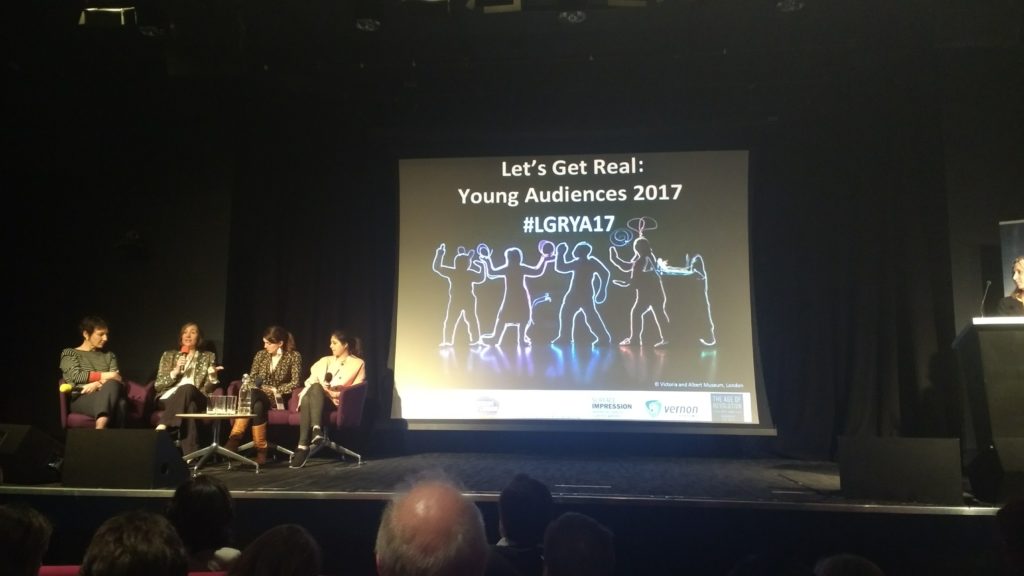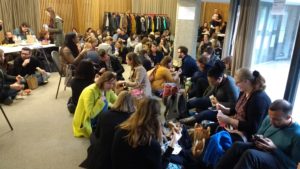
Panel at #LGRYA17
Why do we educate our children in the way we do? Our current public debate seems stuck on raising standards, improving parental choice, and beating international league tables; rather than considering this deeper question. Yes, kids need to be prepared to work – but we also need to nurture their identity and feed their creativity.
Yet, most children in the UK are being deprived full access to a cultural education. There are 2500 museums in the UK, and 10x as many schools. This does not mean that there are 10 schools working with each museum, or that all children, wherever they live in the UK, get access to a museum for 1/10th of their education. If you start to include the numbers of theatres, galleries, heritage sites, libraries and other cultural spaces that could be part of the education (both formal and informal) of a school aged child, it is hard to look at the numbers of opportunities kids get, as being acceptable. Yet we know that middle class urban kids receive more cultural capital than rural, working class kids and this gives them an advantage.
It is easy to look at “digital” as a solution to these problems of access. Considerable amounts of public money have been spent by cultural organisations on digital projects to improve this situation. However, there has been very little sharing of what works, or progress in working more collaboratively with schools and children. To look more carefully at this issue and bring people together to share ideas, Let’s Get Real is a research project and conference organised by Culture24, who work connecting the arts and cultural sector.
There have already been wonderful posts summarising the wonderful speakers, workshops and discussions from the day – such as this from Arts Council England’s Adam Koszary . As one of the speakers, and workshop facilitators, it might be a little unrepresentative for me to share too much of my view of the day.
My own talk was slightly impacted by the cold remedies I was taking and I talked way too fast!
So, with all my speakers notes included – here is it for those who would like to take a bit more time to digest the ideas I shared.
Throughout the day, I was blown away by some of the wonderful work being done that we heard from our inspiring speakers, such as the Holocaust Centre’s virtual testimonies, and the practical interventions of Amy Cotterill in Essex.
The Let’s Get Real action research projects themselves were also deeply impressive in how well they had connected with the needs and questions from kids. However, in all the conversations I had with people in the breaks, I heard another narrative.
I heard it first from Finbarr Whooley, the Director of Content at the Museum of London, who had introduced the day for us. Finbarr came to talk to me after my presentation about one slide in particular – where I shared my experience of conducting the 5xWhys activity with an arts organisation – for them to admit that the reason they were working with schools was to raise the profile of their work, rather than to help children learn or teachers to support that learning.
They started with what they wanted to do with young people, and worked backwards to find a rationale. Finbarr confessed that he’d seen this reverse thinking all too often and that it almost defined the way that the cultural sector worked with digital. I spent the rest of the day listening for this story, and it was not hard to find.
Cultural, arts and heritage organisations are struggling to make good use of digital with young audiences – yet seem to have no vehicle for improvement – no way to change the narrative.
I think some of this can be explained by institutional inertia, incentives for gaming the funding process, and ignorance. However, there are things that we can do.
1 – Create a sustained platform/space for sharing and collaboration with educators and young people. Both #LGRYA17 and #TMCulture24 were proof that more is needed.
2 – Maintain a focus on a genuine purpose for authentic learning. Publishing the aims of a project and evidence of working with learners to iterate a better experience would help to encourage others to keep their ‘Why?’ more meaningful.
3 – Develop more meaningful metrics than trying to link event impact to exam results, or prove engagement via hits on a webpage.
4 – Tell the stories, especially when they fail. Cultural professionals should be able to reflect on their practice, and admit where they made a mistake and show they are learning. There needs to be a more compelling framework for doing this and an incentive to counter the
I loved being part of #LGRYA17 and hope to maintain my involvement with the organisations I spoke to. Thanks to Anra Kennedy for inviting me to help curate the day and to the whole Culture24 team for their support on the day.
I help organisations create and support more engaging learning through the use of digital technology.
If you’d like to talk about how I can help your organisation, to build on the learning from #LGRYA17, please get in touch eylan AT ezekiels DOT co DOT uk.


Pingback: Four reasons to cry (if you are a museum educator) | Eylan Ezekiel